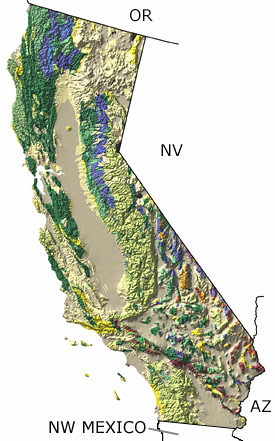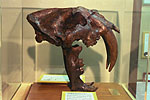California, US
|
|
|
Paleontology and geologyThe Precambrian and Paleozoic: Sedimentary rocks from the Precambrian and Early Paleozoic are most often found in the White Mountains, Inyo Mountains, and near Death Valley in Southern California. The Precambrian rocks rarely contain fossils, but deposits from the Cambrian through Devonian contain numerous fossils, such as corals, ammonites, and brachiopods, indicating a shallow, warm water environment teeming with life. The fossil record of the later Paleozoic (Carboniferous and Permian), best represented in Northern California (Shasta and Butte Counties), indicates both shallow and deep water deposits, as well as swamps and estuarine environments. Some of the late Paleozoic rocks are most likely exotic terranes that were carried in from the west as a result of tectonic activity. The Mesozoic: The Mesozoic was a time of extensive tectonic activity and volcanism associated with the rise of the Sierra Nevada. As these mountains eroded, their deposits accumulated in the Central Valley forming the rocks of the Great Valley Sequence. Mesozoic rocks and fossils from marine and terrestrial environments are broadly distributed throughout the state. This fossil record includes a high diversity of invertebrates, as well as marine reptiles, ginkgoes, cycads, and conifers. The Cenozoic: During the Tertiary, tectonic and volcanic activity that began in the Cretaceous continued to uplift the Coast and Transverse Ranges. Shallow marine, estuarine, freshwater, and terrestrial rocks were deposited around the state as sea levels fluctuated. Glaciers, lakes, and large river systems developed during the Quaternary. Well-preserved fossils from their deposits reveal a flora and fauna not too different from that of today. Deposits like the La Brea Tar Pits remind us that numerous large vertebrates, such as the saber-tooth cats, camels, and mammoths, also roamed the state. |
Links to more on California paleontology |
|
Organizations | Education and Exhibits | Research and Collections | Resources
Organizations
Museums (showing 3 of 7 listings)
The University of California Museum of Paleontology: The University of California Museum of Paleontology web site offers a wealth of information on geologic time, paleontology, evolution, and much more.
George C. Page Museum: Explore a virtual exhibit about the Tar Pits, learn about the animals and environments of California during the Quaternary, and find information on when, where, and how to visit the La Brea Tar Pits.
San Diego Natural History Museum: This museum houses a wide variety of exhibits on California natural history.
 More Museums More Museums
 Top of List Top of List
Colleges and Universities (showing 3 of 4 listings)
UC Berkeley Department of Integrative Biology: One of the premier paleobiology programs.
UCLA Department of Ecology and Evolutionary Biology: General information about the Dept of Ecology and Evolutionary Biology at UCLA, which includes study in paleobiology.
Occidental College Department of Geology: Occidental College offers undergraduate courses in paleontology.
 More Colleges and Universities More Colleges and Universities
 Top of List Top of List
Government Agencies (showing 2 of 2 listings)
California Geological Survey: Find information, maps, and publications about the paleontology, geology, and natural resources of California.
Dr. John D. Cooper Archaeological and Paleontological Center: The Dr. John D. Cooper Archaeological and Paleontological Center is dedicated to preserving the natural and cultural history of Orange County, California. The Cooper Center, a partnership between O.C. Parks and California State University Fullerton, is committed to the preservation, curation, and management of the fossils and artifacts collected within the County.
 Top of List Top of List
Education and Exhibits
Virtual Exhibits (showing 3 of 5 listings)
Geology and Paleontology of Red Rock Canyon: See vertebrate fossils collected in our popular weekend field trips by the Natural History Museum of Los Angeles County 
"Joe" the Dinosaur: Meet "Joe", the nearly complete skeleton of a baby Parasaurolophus that lived in Utah over 75 million years ago. The dinosaur, discovered by a high school student, was around 6 feet long and under a year old when it died.
Mastodon in Oakland! the Rustler Ranch Project: This site features the story of a mastodon excavated and prepared by The Oakland Museum of California science preparation staff. Contains information on mastodons as well as fossil excavation and preparation techniques.
 More Virtual Exhibits More Virtual Exhibits
 Top of List Top of List
Physical Exhibits (showing 1 of 1 listings)
Natural History Museum of Los Angeles County: Largest natural history museum of California and parent organization for George Page Museum. Here, find information on when, where, and how to visit the LACM. Site includes information on the physical exhibits, virtual exhibits, and on-going research at the museum.
 Top of List Top of List
Research and Collections
Ongoing Research Projects (showing 1 of 1 listings)
Research at the Raymond M. Alf Museum of Paleontology: A description of the holdings and current research underway at the museum.
 Top of List Top of List
Resources
Image Collections (showing 1 of 1 listings)
Some Fossil Brachiopods: Images of several fossil brachiopods, dating in geologic age from early Cambrian to Pleistocene, with explanatory text.
 Top of List Top of List
Field Guides (showing 3 of 11 listings)
Fossils At Red Rock Canyon State Park, California: This site is devoted to the paleontology, geology, and natural history of Red Rock Canyon State Park, California; many images of fossils, scenic images of the park, plus images of wildflowers.
The Sharktooth Hill Bone Bed, Southern California: Take a virtual field trip to the classic Sharktooth Hill fossil bone bed northeast of Bakersfield, California; includes text, images of fossils, on-site images and paleontology links.
Fossil Plants Of The Ione Basin, California: The fossil plants of the Middle Eocene Ione Formation, Amador County, California; many images of fossil leaves, plus on-site images of field trips to the fossil leaf localities.
 More Field Guides More Field Guides
 Top of List Top of List
Courses and Lectures (showing 1 of 1 listings)
Paleogeography of the Southwestern U.S.: The paleogeography of the southwestern U.S. from 1.8 billion years ago to 10 million years ago. Text and images by Dr. Ron Blakey from Northern Arizona University.
 Top of List Top of List
General Reference (showing 2 of 2 listings)
Fossils From The Kettleman Hills, California: The 4.5 to 2.0 million-year-old Pliocene-age fossils that occur in the Kettleman Hills, roughly 80 miles northwest of Bakersfield, California.
Fossils In Death Valley National Park: The paleontology, geology and natural wonders of Death Valley National Park (and more); many images of fossils; field trips; paleontology links, plus links to Death Valley.
 Top of List Top of List
|
|



